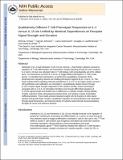| dc.contributor.author | Arneja, Abhinav | |
| dc.contributor.author | Johnson, Hannah | |
| dc.contributor.author | Gabrovsek, Laura | |
| dc.contributor.author | White, Forest M. | |
| dc.contributor.author | Lauffenburger, Douglas A | |
| dc.date.accessioned | 2015-10-27T17:50:06Z | |
| dc.date.available | 2015-10-27T17:50:06Z | |
| dc.date.issued | 2013-12 | |
| dc.date.submitted | 2013-09 | |
| dc.identifier.issn | 0022-1767 | |
| dc.identifier.issn | 1550-6606 | |
| dc.identifier.uri | http://hdl.handle.net/1721.1/99480 | |
| dc.description.abstract | IL-2 and IL-15 are common γ-chain family cytokines involved in regulation of T cell differentiation and homeostasis. Despite signaling through the same receptors, IL-2 and IL-15 have non-redundant roles in T cell biology, both physiologically and at the cellular level. The mechanisms by which IL-2 and IL-15 trigger distinct phenotypes in T cells remain elusive. To elucidate these mechanisms, we performed a quantitative comparison of the phosphotyrosine signaling network and resulting phenotypes triggered by IL-2 and IL-15. This study revealed that the signaling networks activated by IL-2 or IL-15 are highly similar and that T cell proliferation and metabolism are controlled in a quantitatively distinct manner through IL-2/15R signal strength independent of the cytokine identity. Distinct phenotypes associated with IL-2 or IL-15 stimulation therefore arise through differential regulation of IL-2/15R signal strength and duration because of differences in cytokine–receptor binding affinity, receptor expression levels, physiological cytokine levels, and cytokine–receptor intracellular trafficking kinetics. These results provide important insights into the function of other shared cytokine and growth factor receptors, quantitative regulation of cell proliferation and metabolism through signal transduction, and improved design of cytokine based clinical immunomodulatory therapies for cancer and infectious diseases. | en_US |
| dc.description.sponsorship | National Institutes of Health (U.S.) (Grant U54CA11927) | en_US |
| dc.description.sponsorship | National Institutes of Health (U.S.) (Grant R01 AI065824) | en_US |
| dc.description.sponsorship | United States. Army Research Office (Institute for Collaborative Biotechnologies Grant W911NF-09-0001) | en_US |
| dc.language.iso | en_US | |
| dc.publisher | American Association of Immunologists | en_US |
| dc.relation.isversionof | http://dx.doi.org/10.4049/jimmunol.1302291 | en_US |
| dc.rights | Creative Commons Attribution-Noncommercial-Share Alike | en_US |
| dc.rights.uri | http://creativecommons.org/licenses/by-nc-sa/4.0/ | en_US |
| dc.source | PMC | en_US |
| dc.title | Qualitatively Different T Cell Phenotypic Responses to IL-2 versus IL-15 Are Unified by Identical Dependences on Receptor Signal Strength and Duration | en_US |
| dc.type | Article | en_US |
| dc.identifier.citation | Arneja, A., H. Johnson, L. Gabrovsek, D. A. Lauffenburger, and F. M. White. “Qualitatively Different T Cell Phenotypic Responses to IL-2 Versus IL-15 Are Unified by Identical Dependences on Receptor Signal Strength and Duration.” The Journal of Immunology 192, no. 1 (December 2, 2013): 123–135. | en_US |
| dc.contributor.department | Massachusetts Institute of Technology. Department of Biological Engineering | en_US |
| dc.contributor.department | Massachusetts Institute of Technology. Department of Biology | en_US |
| dc.contributor.department | Koch Institute for Integrative Cancer Research at MIT | en_US |
| dc.contributor.mitauthor | Arneja, Abhinav | en_US |
| dc.contributor.mitauthor | Johnson, Hannah | en_US |
| dc.contributor.mitauthor | Gabrovsek, Laura | en_US |
| dc.contributor.mitauthor | Lauffenburger, Douglas A. | en_US |
| dc.contributor.mitauthor | White, Forest M. | en_US |
| dc.relation.journal | The Journal of Immunology | en_US |
| dc.eprint.version | Author's final manuscript | en_US |
| dc.type.uri | http://purl.org/eprint/type/JournalArticle | en_US |
| eprint.status | http://purl.org/eprint/status/PeerReviewed | en_US |
| dspace.orderedauthors | Arneja, A.; Johnson, H.; Gabrovsek, L.; Lauffenburger, D. A.; White, F. M. | en_US |
| dc.identifier.orcid | https://orcid.org/0000-0002-1545-1651 | |
| mit.license | OPEN_ACCESS_POLICY | en_US |
| mit.metadata.status | Complete | |
